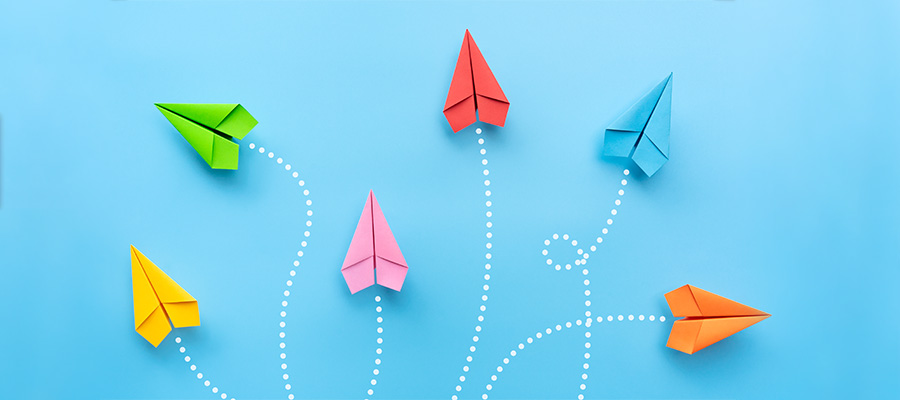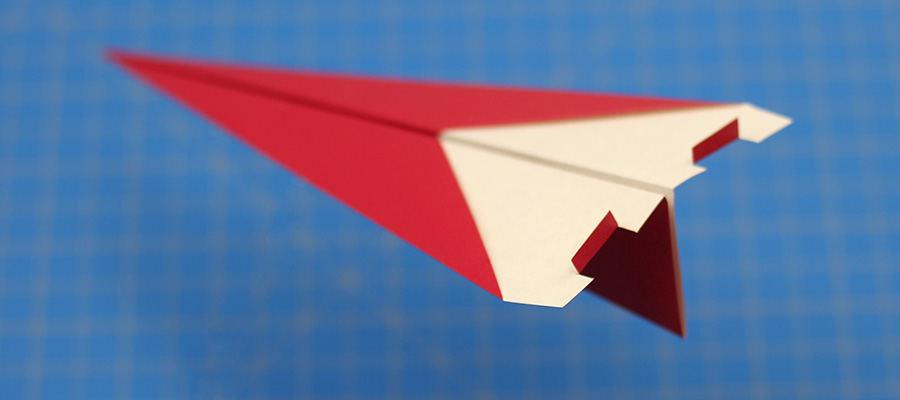How to Steer a Paper Airplane
Learn how to make your paper airplane go straight, turn right or curve left by adjusting the rudder. Make your paper airplane climb, dive or spin by adjusting the ailerons or elevators.

Every paper airplane that you make will require some small adjustments to perfect its flight. Small asymmetries in how you fold it can make it veer to the left or right. If you are throwing at an angle to the wind, this can also cause your paper airplane to turn. By adjusting the rudder, ailerons and elevators you can make your paper airplane fly straight.
Some paper airplanes may have a tendency to dive towards the ground or quickly rise and then stall. This could be because the center of mass is too far forward or backwards. By adjusting the center of mass or the ailerons and elevators you can correct the flight of your paper airplane and get it to fly level.
After reading this page, you will be an expert at how to steer your paper airplane where you want it to fly.
Aerodynamic Terms
Before we dive into ways to steer your paper airplane, let's first make sure we understand the terms that are involved. Roll, yaw and pitch are terms that are used to describe rotations of the airplane around different axes. Thrust, drag, weight and lift are terms used to describe forces that are acting on an airplane.
Axis of Rotation

Every object has three axes around which you can rotate it. In geometry we traditionally call these axes x, y and z. On an airplane, we call these roll, yaw and pitch. The roll axis rotates an airplane around the long dimension straight down the fuselage. If you were on the airplane you would feel it tipping left or right. The yaw axis rotates an airplane around its center, turning the airplane left or right in the same way you would steer a car. The pitch axis rotates the airplane up or down around its center, making it climb or dive.
Forces

A force is something that pulls or pushes on an object. In an airplane, there are four forces worth talking about. The force of gravity pulls all objects downwards. An airplane uses the force of lift to counter the force of gravity. Lift is produced by air moving over the wings. If there is more lift than gravity the airplane goes up. Lift can be controlled by changing the shape of the wings or speed of the air moving over them.
The engines on an airplane produce a force called thrust that pushes an airplane forwards. In a paper airplane the only thrust given is at the very beginning when you throw it. The force that counters thrust is called drag which is caused by friction with the air. Having an airplane with a streamlined aerodynamic shape can reduce drag and prevent the airplane from slowing down as much.
Control Surfaces
Most commercial airplanes have a wing in the middle of the fuselage and a tail at the end. Both the wing and the tail have control surfaces that can be used to steer the airplane. The flaps on the wings are called ailerons and the horizontal flaps on the tail are called elevators. The vertical control surface on the tail is called a rudder.
Some jet airplanes and most paper airplanes have a single wing that goes all the way to the back. This is a tailless or "delta wing" design. In these types of airplanes the function of the ailerons and elevators are combined into a control surface called an elevon.
Knowing how these control surfaces affect an airplane will help you steer it where you want it to go.
Paper Airplane Rudders

A rudder is a vertical control surface on the rear of the airplane. Moving this flap will affect the "yaw" or rotation of the airplane around the vertical axis. In other words, it makes the airplane turn left or right. However, using the rudder by itself will turn an airplane only very slowly. In practice, the ailerons are used in combination with the rudder to make tighter turns.
Most paper airplanes have a vertical piece at the back. This helps stabilize the airplane and prevent it from rolling side to side. If you cut a small flap, or make a small bend, you can make a rudder. Try it!

Rudders are rarely useful for steering paper airplanes. There are two reasons for this. First, they have a very small effect on turning. When you consider the short flight time of paper airplanes, this small effect is not useful. Second, a rudder causes an airplane to fly at an angle to the wind. This is called "sideslip". When you combine sideslip with a positive dihedral angle, this can cause the paper airplane to spiral out of control.
Paper airplane rudders aren't super helpful, but they can be fun to play with.
Paper Airplane Ailerons

The flaps on the wings of an airplane are called ailerons. Ailerons only exist on paper airplanes that have a distinct wing and tail. To make ailerons, you can make very small bends to the wings of your paper airplane. If you want, you can use scissors to make little flaps. Moving these flaps can cause the airplane to "roll" left or right. This roll will cause the airplane to bank and turn in that direction.
Pretend that you are the pilot looking out the front of the airplane. If you move the left aileron up and the right aileron down, your airplane will roll and bank left. If you reverse this and move the left aileron down and the right one up, you will roll and bank right. Just remember, the paper airplane will roll in the direction of the aileron that is pointed up.

Small adjustments to the ailerons can make a big effect, so start small and experiment to see what works best for your paper airplane. If you make a very large aileron adjustment you can make the airplane spin and do tricks. Paper airplanes that have wide wings or a tall body tend to be more stable than skinny airplanes, so the size of the aileron and the amount that you bend it will vary depending on the style of paper airplane you are using.
Paper Airplane Elevators
The horizontal flaps on the tail of an airplane are called elevators. Moving these flaps can cause the airplane to "pitch" up or down. This causes the airplane to climb or dive.


Bend both flaps up to make the airplane go up. Point both flaps down to make the airplane go down. Adjusting the elevators is a great way to tweak your paper plane to make it will fly further. If your airplane tends to head upwards and stall, then you can bend the elevators slightly down to make the airplane have a more level flight. If your airplane always heads for the floor, you can bend the elevators up a bit. You might also be able to adjust the center of mass to do the same thing.
If you make a very large adjustment, you might be able to make your paper airplane do a loop-de-loop.
Paper Airplane Elevons
Most paper airplanes have a "delta wing" design. This means that it has a solid wing all the way to the back without a distinct tail. In these styles, the horizontal control surfaces are called elevons and they control both the "roll" and the "pitch". Bend the elevons in different directions to control roll, like an aileron. Bend them in the same direction to control pitch, like an elevator.


To make the paper airplane both roll and pitch at the same time, you will need to bend the flaps different amounts. For example, to make the paper airplane climb and turn left, you would bend the left elevon up a lot and the right elevon up a little. Play around with it until you get a feel for how much bending is necessary. It doesn't take much.


Paper airplanes that have wide wings or a tall body tend to be more stable along the roll axis than skinny airplanes, so the amount that you bend the elevons will vary depending on the style of paper airplane.
Center of Mass Adjustments

The center of mass of an airplane is the point at which it would balance if suspended from a string at that point. This should be around the middle of the airplane. If the center of mass is too far forwards, the nose will tend to dive down. If the center of mass is too far backwards, the tail of your airplane will tend to fall down and your airplane will stall. You can adjust the center of mass by using small weights, like paper clips, staples or tape.
The center of lift on an airplane is the point at which the lift produced by the wings is balanced out. The wings of paper airplanes generally don't produce a lot of lift because of their shape, but they can produce a little. The ideal location for the center of mass is slightly forward of the center of lift. However, it's difficult to find the center of lift on a paper airplane, so you'll just have to experiment.
Dihedral Angle

The dihedral is the angle between the two wings. If the wings are tipped upwards then there is a dihedral angle. If both wings are perfectly flat, then there is no dihedral angle. If the wings are tipped downwards then the angle is negative, which is called an anhedral angle.
Having a small dihedral angle on your paper airplane will cause it have a more stable flight and will help prevent it from spinning. An airplane with an anhedral angle may be unstable and will likely flip over or spin as it flies. Therefore it is advisable to put a slight dihedral angle on your paper airplane wings, unless you want them to be acrobatic.

Because paper airplane wings are flexible, the dihedral angle has a tendency to increase during flight as the lift on the wings pulls the wings upwards, so you might want to fold your paper plane with a smaller dihedral angle than you want it to have during flight.
When a positive dihedral angle is combined with a rudder, this can cause something called the "dihedral effect". The dihedral effect can cause the airplane to roll over. This is partly why rudders are seldom used with paper airplanes.
You should now have a good understanding of the three ways that you can turn a paper airplane (roll, yaw and pitch). You will also have learned how to use a rudder, aileron, elevator and elevon to use them to steer your paper plane. You can also adjust the center of mass and dihedral angle of the wings to optimize its performance.
It will take some practice to learn how much to bend the wings to perfect the flight, so get out there, experiment, and have some fun!
